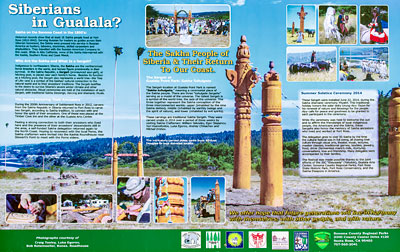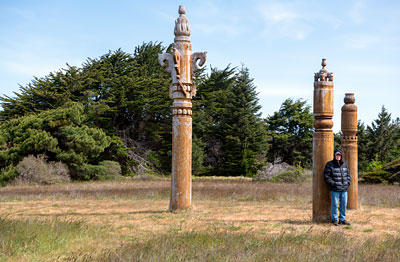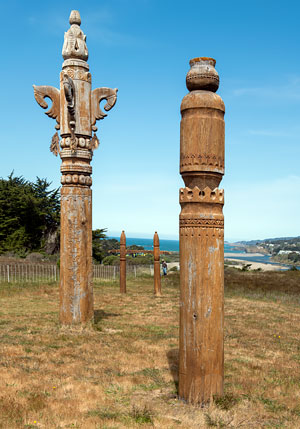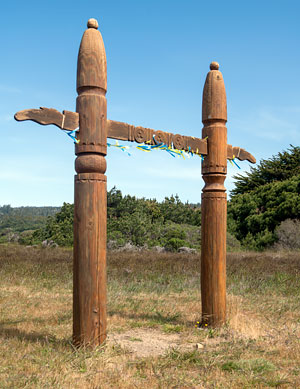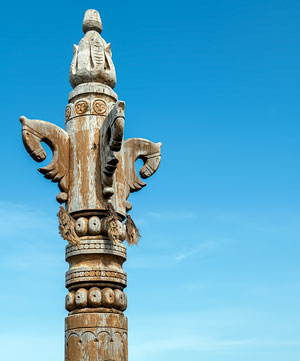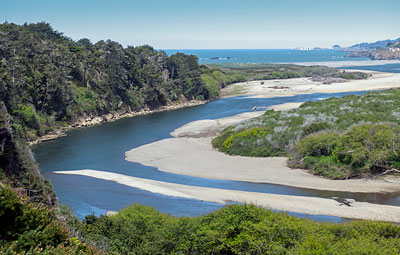Sonoma County Points of Interest
Gualala Point Regional Park
Built 2014
Sakha on the Sonoma Coast in the 1800's:
Historical records show that at least 16 Sakha people lived at Fort Ross (1812-1842). Serving Russian fur traders as guides across their Siberian homeland, the Sakha were pressed into service in Russian America as hunters, laborers, stockmen, skilled carpenters and shipbuilders. They traveled with the Russian American Company to this coast. While In Alta California, some of the Sakha intermarried with the Kashia, Southern Pomo and Coast Miwok.
Who Are the Sakha and What Is a Sergeh?
Indigenous to northeastern Siberia, the Sakha are the northernmost horse breeders in the world, and horses figure prominently in their survival. In the Sakha Republic, a Sergeh (pronounced sayr-geh), or hitching post, is placed near each family's home. Besides Its function as a hitching post, the Sergeh also represents a world tree - the Tree of Life - and is a symbol of the Sakhas' cultural connection to the natural world and to their ancestors' traditions. The Sergeh testifies to the desire to survive Siberia's severe winter climate and other natural obstacles. Ritual ceremonies are held at the installation of each Sergeh, with traditional Sakha blessings, dancing and shamanic rituals.
The Sakha Honoring Their Ancestors
During the 200th Anniversary of Settlement Ross in 2012, carvers from the Sakha Republic in Siberia returned to Fort Ross to carve two Sergeh, according to Sakha tradition, to connect with and honor the spirit of their ancestors. One of those was placed at the Timber Cove Inn and the other at the Gualala Arts Center.
Feeling a strong connection to both their ancestors who lived here and the presence of their ancestors' descendants still in the area, a self-funded Sakha delegation returned again to the North Coast. Hoping to reconnect with the local Pomo, the Sakha craftsmen were invited Into the Kashia Roundhouse near Stewart's Point to meet with the Pomo elders.
The Sergeh at Gualala Point Park: Sakha Tuћulgete
The Sergeh location at Gualala Point Park is named "Sakha tuћulgete," meaning a ceremonial place of the Sakha people. There are three "tuћulgete Sergehs" serving as a model of the universe. The tallest Sergeh Is a symbol of the world tree, the axis of the universe. The three together represent the Sakha conception of the three interconnected worlds: upper {inhabited by the nine Sakha deities), middle (inhabited by earthly beings and the spirit of nature), and lower (inhabited by evil spirits). These carvings are traditional Sakha Sergeh. They were carved onsite in 2014 over a period of three weeks by visiting Sakha Craftsmen: William Yakavlev, Egor Stepanov, Yuri Ksenofontov, Luka Egorov, Andrey Chikachev and Mikhail Ershov.
The intricately carved posts came from 40-foot Douglas fir logs donated locally.
Summer Solstice Ceremony 2014
These Sergeh were installed June 22, 2014, during the Sakha shamanic ceremony Yhyakh. This traditional holiday honors the solar deity Urung Aiyy Toyon for his renewal of nature and blessings for the people. Aiyy calls for peace and goodness to be granted to each participant in the ceremony.
While the ceremony was held to welcome the sun and to affirm the friendships of local indigenous people, the Americans and the Sakha, these Sergehs also honor the memory of Sakha ancestors who lived and worked at Fort Ross.
The delegation grew to over 50 Sakha by the time the cultural festival was in full swing, all sharing their culture through visual arts, theater, music, lectures, master classes, traditional games, textiles, jewelry, food, drink (fermented mare's milk, Kumyss), conversations, love and friendship. Many delegates were accompanied by their families.
The festival was made possible thanks to the joint efforts of the JSC "Elleyc1ada" (Yakutsk), Gualala Arts Center, Sonoma County Regional Parks, Fort Ross State Historic Park, Fort Ross Conservancy, and the Sakha Diaspora in America.
